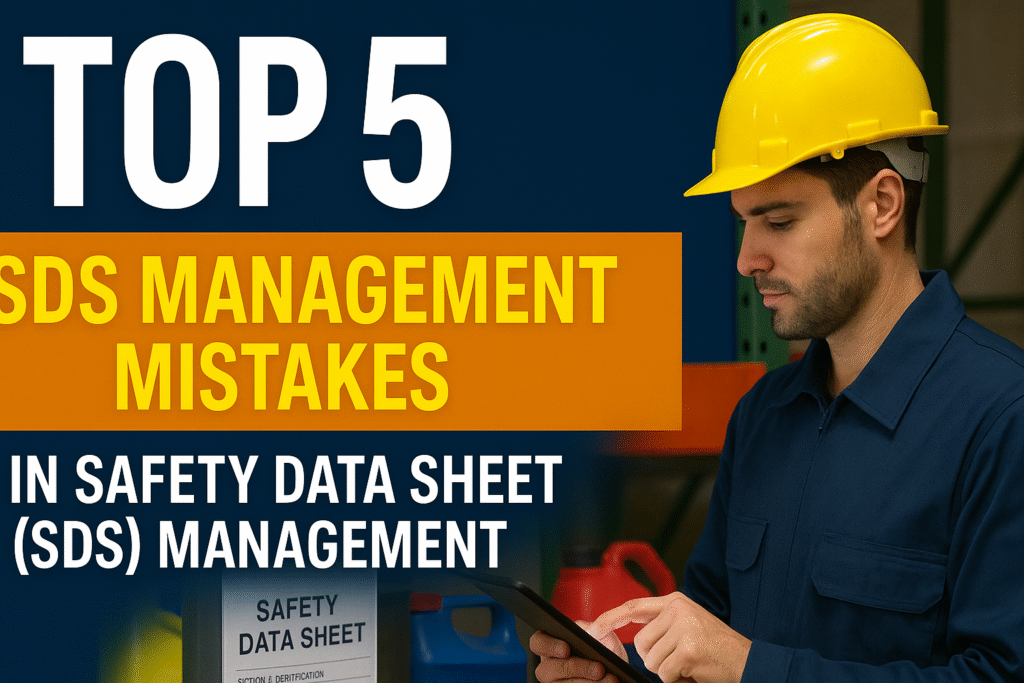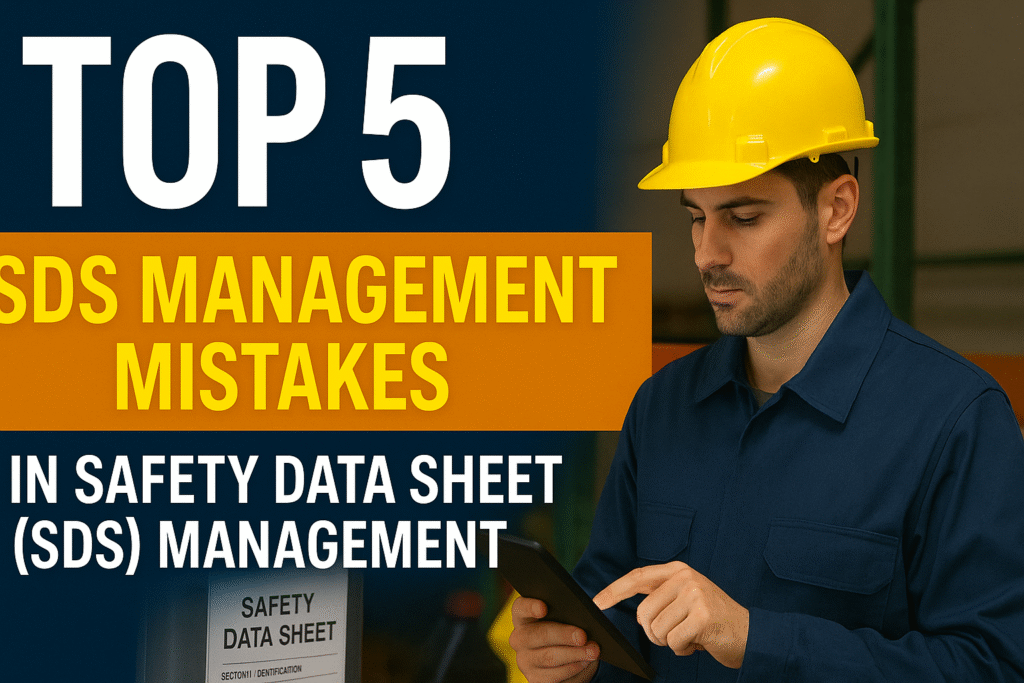Safety Data Sheet (SDS) Management is more than just a regulatory requirement — it’s a crucial part of workplace safety, chemical hazard control, and compliance with occupational health and safety laws.
- Mistake 1 – Keeping Outdated SDSs
- Mistake 2 – Poor Accessibility for Workers
- Mistake 3 – Not Training Workers to Read and Understand SDSs
- Mistake 4 – Relying Only on Paper Copies
- Mistake 5 – Ignoring SDS Compliance During Chemical Purchases
- Quick Reference Table – SDS Management Do’s and Don’ts
- Why Good SDS Management Saves Lives
Safety Data Sheet (SDS) Management
Yet, many organizations treat SDS management as a box-ticking exercise, leading to costly mistakes that put workers, the environment, and legal standing at risk.

According to Workplace Hazardous Materials Information System (WHMIS), every workplace handling hazardous products must ensure SDSs are accessible, accurate, and up to date. Failure to do so can result in fines, injuries, or even fatalities.
This article explores the top 5 mistakes in Safety Data Sheet (SDS) management and how you can avoid them.
Mistake 1 – Keeping Outdated SDSs
One of the most common errors in SDS management is failing to update Safety Data Sheets when the manufacturer releases new hazard information.
An outdated SDS may lack crucial details about chemical hazards, PPE requirements, or first-aid measures.
Why this is risky:
- Workers may follow outdated safety procedures.
- New hazard classifications may go unnoticed.
- Non-compliance with regulations such as WHMIS 2015, OSHA’s Hazard Communication Standard, or GHS requirements.
Best Practice:
- Implement a quarterly SDS review system.
- Subscribe to manufacturer update notifications.
- Store all SDSs in a centralized digital database with automatic update alerts.
Mistake 2 – Poor Accessibility for Workers
A Safety Data Sheet that workers can’t find quickly during an emergency is as good as useless. In some cases, SDSs are stored in locked offices, buried in file folders, or scattered across multiple systems.
Why this is risky:
- Delays in emergency response (e.g., chemical splashes, inhalation incidents).
- Workers unable to identify the correct PPE or first-aid measures.
- Failure to meet the requirement that SDSs be “readily accessible” during work shifts.
Best Practice:
- Use digital SDS management platforms accessible via computers, tablets, or QR codes at workstations.
- For remote or field workers, ensure SDSs are accessible offline via mobile devices.
- Train employees on how to locate and use SDSs during drills and toolbox talks.
Mistake 3 – Not Training Workers to Read and Understand SDSs
Simply having SDSs available does not guarantee workers will understand them. Technical chemical hazard language can be overwhelming, especially for those without prior safety training.

Why this is risky:
- Workers may misinterpret hazard ratings or PPE recommendations.
- Incorrect chemical handling may occur, increasing accident risk.
- Workers may ignore SDSs altogether due to lack of confidence in reading them.
Best Practice:
- Include SDS reading exercises in WHMIS, OSHA HazCom, or GHS training.
- Use real-world chemical examples from your workplace.
- Break down SDS sections during safety meetings — for example:
- Section 2: Hazard Identification
- Section 4: First-Aid Measures
- Section 8: Exposure Controls / PPE
Mistake 4 – Relying Only on Paper Copies
While paper SDS binders are still common, relying solely on them creates serious problems: loss during emergencies, physical damage (e.g., spills, fire), and limited access for remote teams.
Why this is risky:
- Paper copies may be destroyed in incidents.
- Workers in field locations may have no access.
- Version control becomes difficult, increasing the risk of outdated SDSs in circulation.
Best Practice:
- Maintain both paper and digital copies for redundancy.
- Implement cloud-based SDS management software with role-based access.
- Use QR codes on chemical containers linking directly to their SDS.
Mistake 5 – Ignoring SDS Compliance During Chemical Purchases
Many organizations fail to check whether a Safety Data Sheet is provided at the time of purchase or before a new chemical is brought onsite. This creates compliance gaps and delays in safety planning.
Why this is risky:
- Workers may handle hazardous chemicals without hazard awareness.
- Emergency procedures may be missing for new substances.
- Legal non-compliance with WHMIS, OSHA, or GHS rules.
Best Practice:
- Make SDS verification part of the procurement process.
- Require suppliers to send updated SDSs before delivery.
- Refuse shipment until SDSs are provided and reviewed.
Quick Reference Table – SDS Management Do’s and Don’ts
| Do | Don’t |
|---|---|
| Keep SDSs updated every 3 years or when new information is released | Assume manufacturer SDSs never change |
| Store SDSs digitally and in print | Lock SDSs away where workers can’t access them |
| Train all staff on SDS reading and interpretation | Expect workers to figure out SDSs without guidance |
| Use a cloud-based SDS management system | Keep SDSs scattered in different locations |
| Verify SDS availability before chemical purchase | Accept chemicals without documentation |
Why Good SDS Management Saves Lives
Strong Safety Data Sheet (SDS) management not only ensures legal compliance but also protects workers from preventable injuries and exposures.
Properly updated, accessible, and well-understood SDSs mean faster emergency responses, safer chemical handling, and a stronger workplace safety culture.
For more resources on SDS compliance and WHMIS requirements, visit:
- Canadian Centre for Occupational Health and Safety – SDS Guide
- OSHA Hazard Communication Standard
- OHSE.ca – Occupational Safety Articles
Final Word: Avoiding these top 5 mistakes in Safety Data Sheet (SDS) management can drastically improve safety outcomes, reduce regulatory risk, and ensure your workplace is prepared for chemical-related emergencies.
Remember: An SDS is only useful if it’s accurate, accessible, and understood.


No comments yet